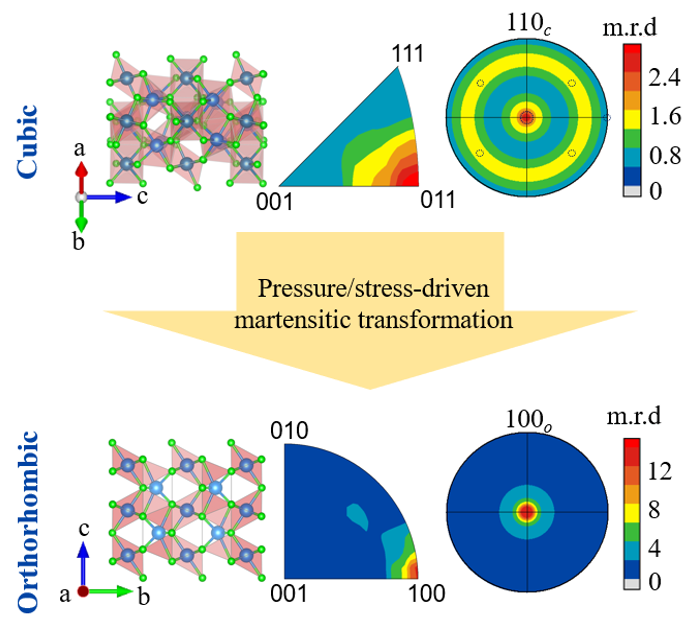Revealing the martensitic transformation mechanism under high pressure - Dr. Binbin Yue
JULY 18, 2019
Variant selection is classic phenomenon during the martensitic transformations that induced by temperature. In the latest issue of PNAS, a team of scientists led by Dr. Binbin Yue from HPSTAR reported a simple variant selection effect across the pressure/stress driven martensitic transformations in Mn2O3. This work is a classic model reference to demonstrate the variant selection behavior under high pressure.
Martensitic transformation (MT) is a solid to solid phase transition due to diffusionless motion of atoms, which are always associated with mechanical, transport and electromagnetic property changes of metals and oxides. MTs have been found in various material systems and are the basic principle for shape memory and superelastic effects.
In MTs, the development of transformation textures is correlated with the particular orientation relationship between the parent phase and the product phase. The orientation relationship will establish some symmetrically equivalent possible orientation variants during the phase transformation. Among all these possible variants, some may be favored during MTs due to microstructures, lattice strains and imposed external stress or strain. This is known as variant selection effect, which has played an important role on the mechanical properties of the final products and received a lot of attention in fields of physics, material science and even Earth science.
Variant selection is commonly found during the MTs that are induced by temperature. However, discovering variant selection in the MTs that are driven by pressure is more of challenge.
Here, the team of scientists led by Drs. Binbin Yue from HPSTAR and Fang Hong who is now working in Chinese Academy of Sciences investigated the stress-induced MT in Mn2O3 by using a method called radial x-ray diffraction in a diamond anvil cell.
"Under high pressure, cubic Mn2O3 will transform to orthorhombic structure,” said Dr. Binbin Yue. “This phase transition has been proposed to be martensitic and the high-pressure phase is isostructural to the post-perovskite (pPv) type MgSiO3 in the deepest lower mantle.”
"Cubic Mn2O3 is a highly symmetric structure, while the high pressure pPv phase is in a low symmetry orthorhombic structure, which makes it a good candidate to investigate variant selection effect under stress”, added Dr. Fang Hong.

Fortunately, they observed the expected MT and variant selection in pressurized Mn2O3 that the only one of the six cubic {110} planes becomes the orthorhombic (100) plane: the one perpendicular to the compression direction.
Their further theoretical calculation also supported this variant selection. “This study reveals a clear and simple variant selection that is attributed to structural distortions under pressure and stress,” said Dr. Bin Chen, one of the corresponding authors.
Caption: Pressure induced martensitic transformation and variant selection in Mn2O3.
马氏体相变是一种常见的无扩散位移型结构相变,最初发现于钢的淬火中。1895年法国学者Osmond将钢淬火后的组织命名为马氏体(martensite),之后在许多不同的材料体系中也发现了具有共同特征的相变。研究马氏体相变的机理,是理解相变过程和调控相变行为的重要环节。在最新出版的《美国科学院院报》上,来自北京高压科学研究中心的岳彬彬研究员领导的研究团队及其合作者报道了高压条件下马氏体相变过程中的变体选择效应。这一成果将有助于加深我们对压力或应力诱导马氏体相变行为的认识。该研究突破了传统的技术壁垒,发展了一种新的技术手段,为马氏体相变研究注入了新鲜的原动力。
